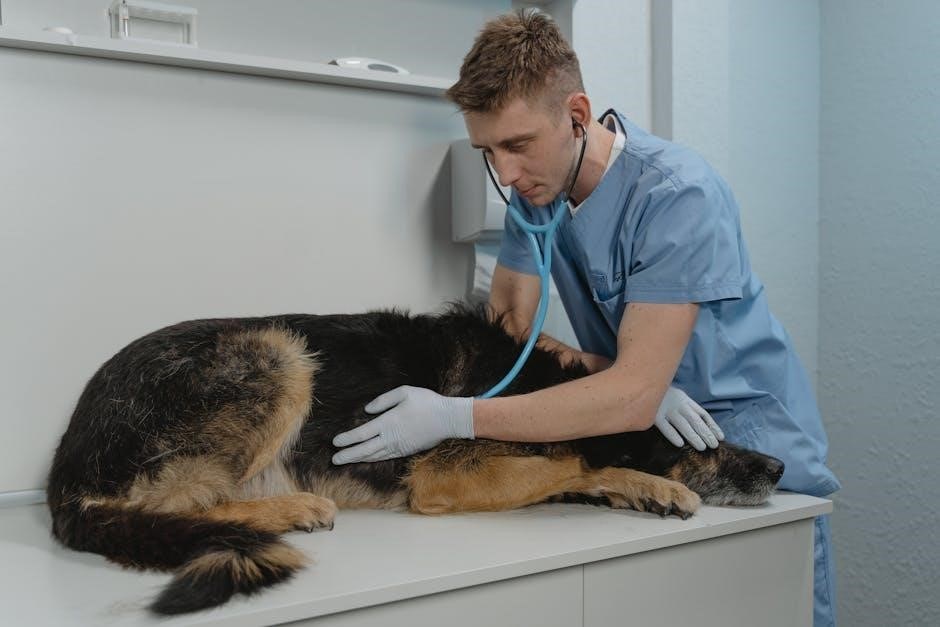
service dog letter from doctor template pdf
Stop searching! Snag a doctor-approved service dog letter template PDF. Easy download, stress-free, and gets you closer to your furry friend! Get yours now!
Service Dog Letter from Doctor: A Comprehensive Guide
This guide provides comprehensive information about service dog letters from doctors․ It will delve into understanding their legal relevance‚ key elements‚ and how to obtain a legitimate letter for housing‚ travel‚ or workplace accommodations․
Understanding Service Dogs and the Law
Navigating the legal landscape surrounding service dogs requires understanding key federal regulations․ The Americans with Disabilities Act (ADA) grants specific rights to individuals with disabilities who utilize service animals․ A crucial aspect involves recognizing that under the ADA‚ service dogs are defined as those trained to perform specific tasks directly related to a person’s disability․ While certification isn’t federally mandated‚ a doctor’s letter can provide supporting documentation․ This letter‚ issued by a licensed healthcare professional‚ validates the medical necessity of the service dog․ Understanding these legal nuances helps ensure compliance and protects the rights of service dog users․ It helps avoid scams․
The Role of a Doctor’s Letter
A doctor’s letter plays a significant role‚ serving as official documentation validating a person’s need for a service dog․ Although not legally required by the ADA for access in public spaces‚ it provides crucial support in various situations․ It’s particularly useful when seeking housing accommodations or workplace adjustments․ Landlords or employers may request documentation verifying the disability and the dog’s assistance․
The letter‚ written by a licensed healthcare professional‚ should clearly state the patient’s diagnosis and how the service dog mitigates the disability’s impact․ It strengthens the individual’s claim and ensures smoother interactions when exercising their rights under the Fair Housing Act or other relevant legislation‚ reducing potential conflicts․

Key Components of a Service Dog Letter
A service dog letter requires specific components to be valid․ These include the doctor’s credentials‚ patient’s diagnosis‚ and a detailed explanation of how the service dog assists with the disability․
Doctor’s Credentials and Contact Information
The service dog letter must prominently display the doctor’s full name‚ professional title (e․g․‚ MD‚ psychiatrist‚ licensed therapist)‚ and license number․ This information validates the doctor’s authority to assess and diagnose the patient’s condition․
Complete contact details‚ including the clinic or practice address‚ phone number‚ and email address‚ should also be included․ This allows verification of the letter’s authenticity and facilitates any necessary follow-up communication․ The letterhead of the medical practice is crucial for establishing legitimacy․ Ensure all information is accurate and clearly legible to avoid any potential issues when presenting the letter for housing‚ travel‚ or other accommodations․
Patient’s Diagnosis and Disability
The letter must explicitly state the patient’s diagnosed disability‚ as defined by the ADA or relevant fair housing laws․ While the specific details of the diagnosis can remain confidential‚ the letter should clearly indicate the impairment․ For example‚ it might state “anxiety disorder” or “post-traumatic stress disorder․”
This section should demonstrate how the disability substantially limits one or more major life activities․ It must establish a clear connection between the diagnosis and the need for a service dog․ The doctor’s professional opinion is essential in validating the patient’s claim and ensuring the letter’s credibility when seeking accommodations or access rights․
Explanation of the Dog’s Assistance
This section outlines the specific tasks the service dog performs to directly mitigate the patient’s disability․ The letter should clearly describe how the dog’s trained behaviors alleviate symptoms or provide assistance․ General statements are insufficient; instead‚ provide concrete examples․
For instance‚ the letter might state the dog “alerts to panic attacks by pawing and providing deep pressure therapy” or “retrieves medication and provides tactile stimulation during episodes of anxiety․” The explanation should emphasize how these tasks enable the patient to function in daily life‚ increasing independence and improving overall well-being․ This section is crucial for establishing the dog’s role as more than just a pet․

Service Dog Letter Template: What to Include
This section outlines the components of a service dog letter template․ It covers essential information‚ sample introductions‚ and statements of necessity for a service dog․
A proper service dog letter should commence with a formal introduction‚ stating the doctor’s name‚ credentials‚ and purpose for writing․ The body should explicitly connect the patient’s diagnosis to the necessity of the service dog․
The letter should describe how the dog mitigates specific symptoms or provides assistance related to the disability․ It needs to clearly articulate the tasks the dog performs‚ directly linking them to the patient’s needs․ The letter should also include the statement that the service dog is essential for the patient’s well-being and ability to function in daily life․
Essential Information: Owner and Dog Details
A service dog letter must contain crucial details about both the owner and the service dog․ The owner’s full name‚ address‚ and contact information should be clearly stated for verification purposes․ Similarly‚ the service dog’s name‚ breed‚ age‚ and any identifying characteristics are necessary․
Including microchip or registration details‚ if applicable‚ can further validate the dog’s identity․ Vaccination records and relevant health information may also be beneficial‚ though not always mandatory․ This section ensures clear identification of both the individual with the disability and their assisting animal‚ minimizing potential confusion or disputes․
Statement of Necessity for the Service Dog
The core of a service dog letter lies in articulating the necessity of the animal for the patient’s well-being․ The doctor must explicitly state that the service dog is required to mitigate the patient’s disability․ This involves detailing how the dog’s specific tasks or work directly alleviate the symptoms or functional limitations caused by the disability․
Simply stating the patient has a disability is insufficient; the letter must connect the dog’s actions to the patient’s needs․ This demonstrates the dog’s active role in enabling the individual to function more independently and safely in various environments․ The statement should be clear‚ concise‚ and directly linked to the diagnosed condition․
Obtaining a Legitimate Service Dog Letter
Acquiring a legitimate service dog letter requires consulting a licensed healthcare professional․ Beware of online scams offering instant approvals‚ as these lack legal validity and may not meet requirements․
Consulting with a Licensed Mental Health Professional
To obtain a legitimate service dog letter‚ consult a licensed mental health professional․ This could be a therapist‚ psychiatrist‚ psychologist‚ licensed clinical social worker‚ or counselor․ These professionals can assess your mental health needs and determine if a service dog is a necessary part of your treatment plan․
A licensed professional ensures the letter’s validity‚ providing it on their official letterhead‚ including their license number․ This professional assessment carries legal weight‚ especially when seeking accommodations under the ADA or Fair Housing Act․ They offer documentation of your diagnosis‚ and the dog’s role in mitigating your disability-related symptoms‚ therefore safeguarding against fraudulent claims․
Avoiding Online Scams and Fake Certifications
Be wary of online scams offering instant service dog certifications or letters․ These certifications hold no legal weight under the ADA․ Legitimate service dog status is based on the dog’s trained tasks‚ not a certificate or registry․
Avoid websites promising quick approvals without proper assessment from a licensed professional․ These are often scams that exploit individuals seeking accommodations․ Instead‚ prioritize consultations with qualified mental health professionals who can provide valid documentation based on genuine need․ Remember‚ a real service dog letter comes from a professional relationship‚ not an online purchase․ Protect yourself by verifying credentials and seeking reputable sources․

Service Dog Training and Certification
While the ADA doesn’t mandate certification‚ proper training is vital․ Effective training ensures the dog reliably performs tasks related to the handler’s disability‚ enhancing their independence and safety․
Training Requirements and Standards
Although the ADA doesn’t specify mandatory certification or minimum training hours‚ service dogs must be individually trained to perform specific tasks directly related to their handler’s disability․ Some private organizations suggest around 120 hours of training over six months․ The dog’s behavior is paramount; it must be well-behaved in public settings․
Effective training also ensures the dog doesn’t pose a threat to others․ The training should cover basic obedience and the specific tasks needed to mitigate the handler’s disability․ Public access tests often evaluate these skills․ While standards vary‚ consistent and thorough training is key․
The Importance of Professional Training
Professional service dog training offers significant benefits‚ even though it’s not legally mandated by the ADA․ Professional trainers understand how to effectively teach dogs to perform tasks reliably in diverse environments․ They can also address behavioral issues that might arise during the training process․
A certified trainer provides expertise in shaping the dog’s behavior‚ ensuring it meets high standards of obedience and public access skills․ This leads to a more confident and capable service dog․ Furthermore‚ professional training can offer guidance to the handler on how to maintain the dog’s skills․

Service Dog Rights and Access
This section explores service dog rights‚ focusing on ADA guidelines for public access․ We will cover housing and workplace accommodations‚ ensuring handlers understand their rights and responsibilities‚ fostering inclusivity and accessibility․
ADA Guidelines and Public Access
The Americans with Disabilities Act (ADA) provides clear guidelines regarding public access for service dogs․ Under the ADA‚ service dogs are generally allowed to accompany their handlers in public places‚ including businesses‚ restaurants‚ and transportation․ Businesses cannot discriminate against individuals with disabilities who use service animals․ They may only ask two questions: is the dog a service animal required because of a disability? And what work or task has the dog been trained to perform?
It’s crucial to understand these rights to ensure equal access and prevent discrimination․ A service dog’s presence is often vital for its handler’s well-being and independence․
Housing and Workplace Accommodations
Beyond public access‚ service dog owners have specific rights regarding housing and workplace accommodations․ The Fair Housing Act (FHA) requires landlords to make reasonable accommodations for individuals with disabilities who require service dogs‚ even if there is a “no pets” policy․ This often involves waiving pet fees or restrictions․
Similarly‚ employers must provide reasonable accommodations under the ADA to allow service dogs in the workplace․ These accommodations ensure that individuals with disabilities can perform their job duties effectively․ A doctor’s letter is essential for requesting these accommodations‚ clearly outlining the necessity of the service dog due to the handler’s disability․